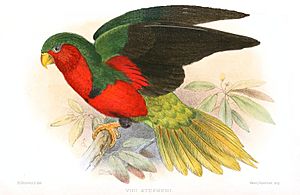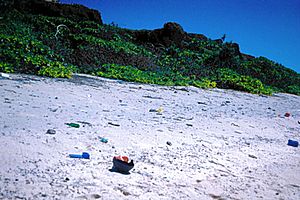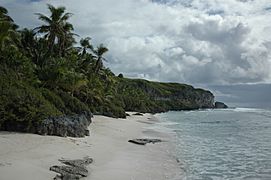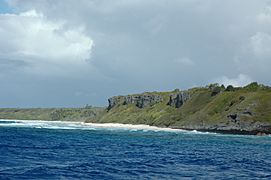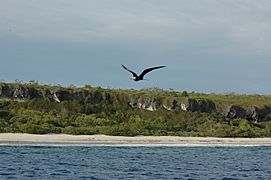Henderson Island (Pitcairn Islands) facts for kids
Quick facts for kids Henderson Island * |
|
|---|---|
| Criteria | natural vii, x |
| Reference | 487 |
| Coordinates | 24°21′S 128°19′W / 24.35°S 128.32°W |
| Inscription history | |
| Inscription | 1988 (12th Session) |
|
|
Henderson Island is a special, uninhabited island in the south Pacific Ocean. It was once called San Juan Bautista and Elizabeth Island. This island is part of the Pitcairn Island Group, along with Pitcairn, Oeno, and Ducie Islands.
Henderson Island is one of the last two raised coral atolls in the world. Its nature is mostly untouched by people. In 2017, a study found a lot of plastic trash on its beaches. The island is home to many unique plants and animals. Ten of its 51 flowering plants, all four of its land birds, and about a third of its insects and snails are found nowhere else. This is amazing for such a small island!
The island is about 9.6 kilometers (6 miles) long and 5.1 kilometers (3 miles) wide. It covers an area of 37.3 square kilometers (14.4 square miles). It is located 193 kilometers (120 miles) northeast of Pitcairn Island. The soil is not good, and there is little fresh water. This means it is not good for farming. There are three beaches on the northern side. The rest of the coast has steep cliffs up to 15 meters (49 feet) high.
In 1902, Henderson Island became part of the Pitcairn Islands colony. The Pitcairn Islands are a British Overseas Territory in the South Pacific. The United Nations made Henderson Island a World Heritage Site in 1988. This means it is a very important place to protect.
Contents
Island History
Scientists believe a small group of Polynesian people lived on Henderson Island between the 1100s and 1400s. We do not know why they left the island. Around the same time, Polynesians also left Pitcairn Island. The people on Henderson likely depended on the Pitcairn group for tools. This is because Henderson has no stone for making tools. The Pitcairn Polynesians might have left because a nearby island, Mangareva, became less powerful. Henderson was at the end of a chain of small colonies that depended on Mangareva.
European Discoveries
On January 29, 1606, a Portuguese captain named Pedro Fernandes de Queirós was the first European to see the island. He named it San Juan Bautista. He was leading a Spanish trip at the time. Later, on January 17, 1819, Captain Henderson rediscovered the island. He was from the British East India Company ship Hercules. Another captain, Henry King, landed on the island on March 2, 1819. He found the British flag already flying. His crew carved the name of their ship, Elizabeth, into a tree.
The Essex Shipwreck
On November 20, 1820, a sperm whale hit and sank the Nantucket whaling ship Essex. The crew reached Henderson Island on December 20 in three small boats. They found the island's only known fresh water source. It was a salty spring on the north shore, visible at low tide. They ate fish, birds, eggs, crabs, and plants. But they ran out of food in about a week.
On December 27, the three boats sailed for South America. Three men, Thomas Chappel, Seth Weeks, and William Wright, chose to stay behind. They survived until they were rescued on April 9, 1821. Chappel said he saw human bones in a cave. This story of a whale sinking a ship might have inspired Herman Melville to write Moby-Dick.
Discovering Ancient Bones
In August 1851, visitors from Pitcairn Island also found bones in a cave. They also found parts of a shipwreck on the beach. In March 1958, Pitcairn Islanders found the bones again. A medical check showed the bones were from people of European descent. They were then buried in the cave. In 1966, an American team studied the bones. They buried them in five coffins in the cave. They thought the bones were from five or six people, including a child. They believed these people were shipwreck survivors who died from not having enough water.
However, a final study in 1991 found that the human bones on Henderson Island were from ancient Polynesians.
British Control and Publicity Stunts
In 1902, Henderson Island, along with Oeno and Ducie islands, officially became part of the British Empire. This happened when Captain G. F. Jones visited the islands. In August 1937, a British ship, HMS Leander, flew over the islands. They planted a British flag on each island. They also put up a sign saying: "This island belongs to H.B.M. King George VI."
In 1957, a 27-year-old American named Robert Tomarchin lived on the island like a castaway for about two months. He had a pet chimpanzee with him! It seemed to be a way to get attention. People from Pitcairn rescued him.
In the early 1980s, an American businessman named Arthur "Smiley" Ratliff wanted to build a large house and an airstrip on the island. The Pitcairn Island Council said yes. But people who wanted to protect nature worked hard to stop it. The British government then said no to the plan. Henderson Island was made a World Heritage Site in 1988 to protect its unique nature.
Natural Resources and Use
Since the 1900s, Pitcairn Islanders have used special boats to visit Henderson. They go there to collect wood from miro and tou trees. They usually go once a year, but sometimes up to three times if the weather is good. The Pitcairners carve this wood into souvenirs for tourists. This helps them earn money.
Geography of Henderson Island
Henderson Island is a coral island that has been lifted up from the sea. It is part of the Pitcairn Island Group. The nearest large land is more than 5,000 kilometers (3,100 miles) away. This island is made of coral limestone. It sits on top of a cone-shaped mound that rises from about 3,500 meters (11,500 feet) deep in the ocean. The surface of the island is mostly broken coral and cut-up limestone. Except for the north end, the island is surrounded by steep limestone cliffs up to 15 meters (49 feet) high.
There are three main beaches on the northwest, north, and northeast sides. The north and northwest beaches are next to coral reefs. The low area in the middle of the island might have been a raised lagoon in the past. There is only one known source of drinking water on the island. It is a salty spring on the north shore. It comes from a crack in a flat rock on the beach and is visible at low tide. The ocean's tide changes about one meter (3 feet) during spring tide.
Plant Life (Flora)

Most of the plants on Henderson Island are untouched by people. Only five types of plants grow near the beaches, including coconut palms. The island is covered by a tangled scrub forest that is 5–10 meters (16–33 feet) tall. There is less forest in the middle of the island.
Henderson Island has 51 types of native flowering plants. Ten of these are unique to the island (endemic), meaning they grow nowhere else. Common trees include coconut palms, Pandanus tectorius, Thespesia populnea (miro), Tournefortia argentea, Cordia subcordata (tou), Guettarda speciosa, Pisonia grandis, Geniostoma hendersonense, Nesoluma st.-johnianum, Hernandia stokesii, Myrsine hosakae, and Celtis sp.
Animal Life (Fauna)
Birds
Henderson Island is home to four types of land birds found only there. These are the Henderson fruit dove, Henderson lorikeet, Henderson reed warbler, and the flightless Henderson crake. Three other types of doves used to live on the island. They became extinct when Polynesians arrived around 1000 CE.
Of the fifteen types of seabirds found, nine or more probably nest on the island. Breeding groups of the endangered Henderson petrel used to live on Ducie Island. But invasive rats wiped them out by 1922. Now, these petrels are believed to nest only on Henderson Island.
Scientists have found bird bones near the old Polynesian settlements. These bones are from 500 to 800 years ago. Some bones are from birds that still visit the island but do not nest there, like the Christmas shearwater. Other bones are from four bird types that are no longer found on the island at all. The Polynesian settlers might have caused these birds, and six types of snails, to disappear from the island. Losing these food sources might have been one reason why the Polynesians left. BirdLife International has named Henderson Island an Important Bird Area. This is because of its unique landbirds and nesting seabirds.
Other Animals
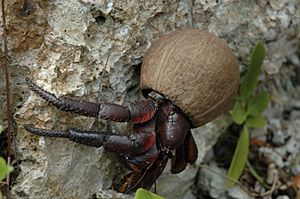
We do not know much about the insects and other small animals on the island. But a third of the island's known snails and insects are found only there. There are no native mammals. However, the Pacific rat, brought by Polynesians 800 years ago, is very common. A type of skink (a lizard) and the green sea turtle have been seen. An unknown type of gecko has also been reported. There are also many crabs.
Protecting Animals from Risks
The number of land birds seems to be stable. But there is a big problem: when boats land on the island without permission, they might bring new dangers. These dangers include new animals that hunt, or new diseases. If the Eurasian black rat or a domestic cat were brought to the island, they would likely cause the ground-dwelling Henderson crake and other species to disappear very quickly. The unique birds might also get sick from a disease called avian pox, which is spread by biting flies. They might not have any way to fight it off.
Between July and November 2011, the Pitcairn Islands Government and the Royal Society for the Protection of Birds worked together. They started a program to get rid of the Pacific rat using poison. The program worked very well! Before the program, between 50,000 and 100,000 rats lived on the island. The poison killed almost all of them. However, between 60 and 80 rats survived, and their population has now grown back to its original size.
Plastic Pollution
A study in April 2017 looked at trash on several beaches. It found "the highest density of plastic rubbish anywhere in the world." This trash comes from the South Pacific Gyre, a large ocean current. The beaches are thought to have about 37.7 million pieces of trash. This trash weighs about 17.6 tonnes (19.4 tons).
On North Beach, a study found that 17 to 268 new pieces of trash washed up each day on just a 10-meter (33-foot) section. The study also noted that purple hermit crabs make their homes in plastic containers found on the beaches. This trash might harm the different types of snails on the shore. It might also reduce the number of sea turtles trying to lay eggs. And it could increase the risk of seabirds getting caught in the trash.
Gallery
Related pages
- Desert island
- List of islands
See also
 In Spanish: Isla Henderson (Islas Pitcairn) para niños
In Spanish: Isla Henderson (Islas Pitcairn) para niños



